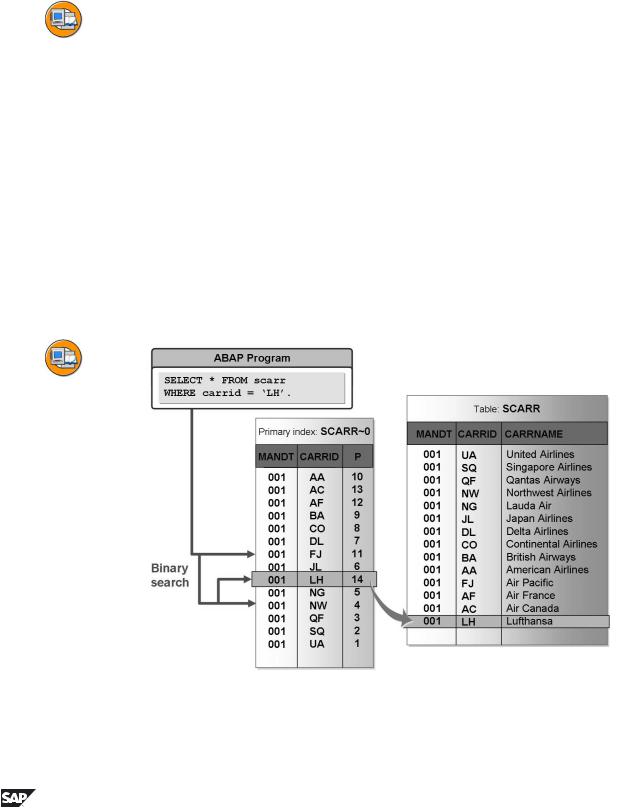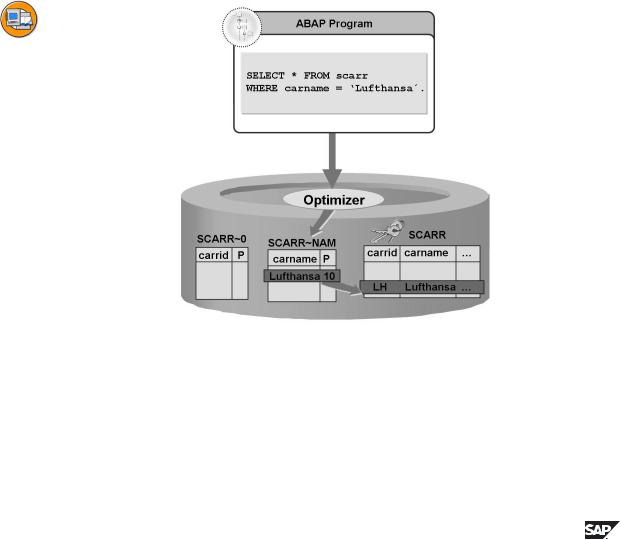
- •Icons in Body Text
- •Introduction to the Dictionary
- •Overview of the functions
- •Data objects in the ABAP Dictionary
- •Data types
- •Exercise 1: Basic Data Types
- •Exercise 2: Simple and Nested Structures
- •Exercise 4: Deep Structures
- •Tables
- •Summary
- •Exercise 5: Tables in the ABAP Dictionary
- •Pooled and cluster tables
- •Performance During Table Access
- •Improved Performance through Access per Index
- •Improving the Performance through Table Buffering
- •Exercise 6: Performance Aspects with Table Access
- •Task 1:
- •Input Checks
- •Input check via the technical domains
- •Object Dependencies
- •Activation and Where-Used List
- •Changes to Tables
- •Database Changes to Transparent Tables
- •Enhancement of SAP Standard Tables
- •Exercise 9: Changes to Database Tables
- •Views and Maintenance Views
- •Restricted or Enhanced Views on Database Tables
- •Exercise 11: Views
- •Creating Maintenance Views
- •Exercise 12: Maintenance Views
- •Search Helps
- •Input helps
- •Exercise 13: Search Helps
- •Table ZEMPLOY##
- •Table ZDEPMENT##
- •Table ZEMPLOY##
- •Table ZEMPLOY##
- •Table ZDEPMENT##
- •Table ZDEPMENT##
- •Check table T000
- •Check table SCARR
- •Check table ZDEPMENT##
- •Check table SCURX
- •Check table STRAVELAG
- •Check table ZDEPMENT##
- •Check table T002

Unit 3
Performance During Table Access
Unit Overview
In this chapter, you will get to know the basic aspects of the efficient table access.
Unit Objectives
After completing this unit, you will be able to:
•Judge when table accesses can be speeded up by using indexes
•Create indexes in the ABAP Dictionary
•Explain the different buffering types
•Judge when it makes sense to buffer a table and which buffering type you should choose
•Buffer a table using the technical settings
Unit Contents |
|
Lesson: Performance During Table Access .................................. |
76 |
Exercise 6: Performance Aspects with Table Access .................. |
91 |
2006/Q2 |
© 2007 SAP AG. All rights reserved. |
75 |

Unit 3: Performance During Table Access |
BC430 |
Lesson: Performance During Table Access
Lesson Overview
Lesson Objectives
After completing this lesson, you will be able to:
•Judge when table accesses can be speeded up by using indexes
•Create indexes in the ABAP Dictionary
•Explain the different buffering types
•Judge when it makes sense to buffer a table and which buffering type you should choose
•Buffer a table using the technical settings
Business Example
Some transactions contain select statements in their applications, which cause very long runtimes. You should now improve the performance without changing the program.
Improved Performance through Access per Index
Figure 30: Structure of an Index
76 |
© 2007 SAP AG. All rights reserved. |
2006/Q2 |

BC430 |
Lesson: Performance During Table Access |
An index can be used to speed up the selection of data records from a table.
An index can be considered to be a copy of a database table reduced to certain fields. The data is stored in sorted form in this copy. This sorting permits fast access to the records of the table (for example using a binary search). Not all of the fields of the table are contained in the index. The index also contains a pointer from the index entry to the corresponding table entry to permit all the field contents to be read.
•When creating indexes, please note:
–An index can only be used up to the last specified field in the selection! The fields that are specified in the WHERE clause for a large number of selections should be in the first position.
–Only those fields whose values significantly restrict the amount of data are meaningful in an index.
–When you change a data record of a table, you must adjust the index sorting. Tables whose contents are frequently changed should not have too many indexes.
–Make sure that the indexes on a table are as disjunct as possible.
Figure 31: Access with Indexes
The database optimizer decides which index on the table should be used by the database to access data records.
2006/Q2 |
© 2007 SAP AG. All rights reserved. |
77 |
